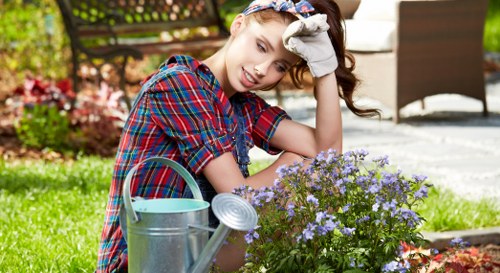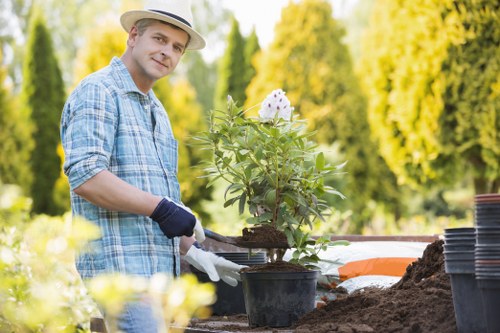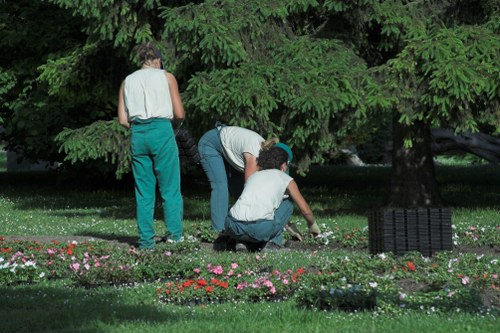Comprehensive Guide to Garden Maintenance in Cranford
Understanding Garden Maintenance

Maintaining a beautiful garden in Cranford requires a strategic approach tailored to the local climate and soil conditions. Whether you're a seasoned gardener or a novice, understanding the fundamentals of garden maintenance is essential for achieving a thriving outdoor space.
Garden maintenance encompasses a variety of tasks aimed at promoting plant health, enhancing aesthetic appeal, and ensuring the longevity of your garden. From regular weeding and pruning to seasonal planting and pest control, each aspect plays a crucial role in the overall success of your garden.
In Cranford, where the climate can vary, it's important to adopt maintenance practices that address both the challenges and opportunities presented by the local environment. This guide will walk you through the essential steps and best practices for effective garden maintenance in Cranford.
Seasonal Garden Maintenance

Spring Maintenance
Spring is a critical time for garden maintenance in Cranford. As temperatures begin to rise, it's the perfect opportunity to prepare your garden for the growing season ahead.
Tasks to Perform:
- Soil Preparation: Test and amend the soil to ensure optimal nutrient levels.
- Planting: Sow seeds and transplant seedlings to establish new plants.
- Pruning: Trim back any dead or overgrown branches to encourage healthy growth.
By addressing these tasks in the spring, you set a strong foundation for a vibrant and resilient garden throughout the year.
Summer Maintenance
Summer presents its own set of challenges, including increased heat and potential drought conditions. Effective maintenance during this season ensures that your garden remains lush and vibrant.
Key Maintenance Activities:
- Watering: Implement a consistent watering schedule, preferably in the early morning or late evening to conserve water.
- Weeding: Regularly remove weeds to prevent them from competing with your plants for resources.
- Pest Control: Monitor for pests and apply natural or chemical treatments as necessary.
Autumn Maintenance

Autumn is the time to prepare your garden for the colder months. Proper maintenance now can prevent issues during winter and ensure a smooth start next spring.
Essential Autumn Tasks:
- Leaf Removal: Clear fallen leaves to prevent mold and pest infestations.
- Soil Enrichment: Add compost or mulch to enrich the soil and protect root systems.
- Plant Protection: Cover sensitive plants to shield them from frost and harsh weather.
These steps help in maintaining soil health and protecting your plants, ensuring they remain healthy throughout the winter.
Winter Maintenance

Winter in Cranford can be harsh, but with the right maintenance practices, your garden can emerge unscathed and ready for the next growing season.
Winter Care Tips:
- Mulching: Apply a thick layer of mulch to insulate plant roots against freezing temperatures.
- Tool Maintenance: Clean and store garden tools properly to prevent rust and damage.
- Planning: Assess the past year's garden performance and plan for improvements in the coming season.
Taking these precautions ensures that your garden remains protected during the dormant winter months, allowing for a quicker recovery in spring.
Essential Garden Tools for Cranford Maintenance

Basic Tools Every Gardener Needs
Having the right tools is fundamental to effective garden maintenance. In Cranford, where the soil and climate pose specific challenges, investing in quality tools can make a significant difference.
Must-Have Tools:
- Pruning Shears: Ideal for trimming and shaping plants.
- Garden Fork: Essential for turning soil and aerating beds.
- Watering Can or Hose: Ensures your plants receive adequate moisture.
- Gloves: Protect your hands from thorns, dirt, and pests.
These tools not only make maintenance tasks easier but also help in achieving professional-looking results in your garden.
Advanced Tools for Enhanced Maintenance
For those looking to take their garden maintenance to the next level, advanced tools can offer additional functionality and efficiency.
Recommended Advanced Tools:
- Lawn Mower: Keeps your lawn neat and well-maintained.
- Leaf Blower: Efficiently clears fallen leaves and debris.
- Compost Bin: Facilitates sustainable garden waste management and soil enrichment.
Incorporating these tools into your maintenance routine can save time and enhance the overall health and appearance of your garden.
Choosing the Right Plants for Cranford Gardens
Climate-Appropriate Plant Selection
Selecting plants that thrive in Cranford's climate is crucial for minimizing maintenance efforts and ensuring a flourishing garden.
Top Plants for Cranford:
- Hydrangeas: Known for their vibrant blooms and adaptability.
- Eucalyptus: Offers aromatic foliage and resilience.
- Lavender: Provides color and attracts pollinators.
These plants are well-suited to the local conditions, requiring less water and maintenance while providing year-round beauty.
Drought-Tolerant Varieties
Given the occasional dry spells in Cranford, incorporating drought-tolerant plants can reduce water usage and maintenance frequency.
Recommended Drought-Tolerant Plants:
- Succulents: Store water in their leaves, making them highly resilient.
- Yucca: Features striking foliage and minimal water requirements.
- Agave: Adds architectural interest with its bold structure.
These plants not only conserve water but also add unique textures and forms to your garden landscape.
Irrigation and Water Management
Efficient Irrigation Systems
Proper irrigation is vital for maintaining a healthy garden in Cranford. Selecting an efficient system ensures that your plants receive adequate moisture without wastage.
Types of Irrigation Systems:
- Drip Irrigation: Delivers water directly to the plant roots, minimizing evaporation.
- Sprinkler Systems: Suitable for larger areas but can be less efficient.
- Soaker Hoses: Provides even moisture distribution for garden beds.
Implementing the right irrigation system can significantly reduce water consumption and promote sustainable garden practices.
Rainwater Harvesting
Collecting and utilizing rainwater is an eco-friendly way to supplement your garden's water supply, especially during dry periods.
Benefits of Rainwater Harvesting:
- Cost Savings: Reduces your dependence on municipal water sources.
- Environmental Impact: Decreases runoff and conserves water resources.
- Plant Health: Provides naturally soft water, free from chemicals.
Setting up a rainwater harvesting system can enhance your garden's resilience and sustainability.
Pest and Disease Management
Identifying Common Pests in Cranford
Garden pests can pose significant threats to plant health and productivity. Recognizing and managing these pests is essential for effective garden maintenance.
Common Pests to Watch For:
- Aphids: Small insects that suck plant sap, causing wilting and deformities.
- Slugs and Snails: Damage plant leaves and stems, especially during damp conditions.
- Japanese Beetles: Feed on a wide range of plants, leaving behind skeletal remains.
Early detection and targeted treatments are key to preventing extensive damage.
Preventive Measures and Treatments
Implementing preventive strategies can reduce pest populations and minimize the need for chemical interventions.
Effective Pest Control Methods:
- Companion Planting: Growing certain plants together can naturally repel pests.
- Biological Controls: Introducing beneficial insects like ladybugs to combat harmful pests.
- Organic Pesticides: Use environmentally friendly options to manage infestations.
By adopting these methods, you maintain a healthy garden ecosystem while minimizing environmental impact.
Soil Health and Fertility
Importance of Healthy Soil
Healthy soil is the foundation of a thriving garden. It provides essential nutrients, supports plant structures, and fosters beneficial microbial activity.
Key Components of Healthy Soil:
- Organic Matter: Enhances soil structure and fertility.
- pH Balance: Ensures optimal nutrient availability for plants.
- Drainage: Prevents waterlogging and root diseases.
Maintaining these components through regular amendments and testing can significantly improve your garden's productivity.
Soil Amendment Practices
Regularly amending your soil with organic and inorganic materials can enhance its properties and support plant growth.
Effective Soil Amendments:
- Compost: Adds nutrients and improves soil texture.
- Manure: Provides a rich source of organic matter.
- Peat Moss: Increases soil aeration and moisture retention.
Incorporating these amendments into your soil maintenance routine ensures a nutrient-rich environment for your plants.
Pruning and Trimming Techniques
Benefits of Regular Pruning
Pruning is a critical maintenance task that promotes plant health, encourages growth, and enhances the aesthetic appeal of your garden.
Main Benefits:
- Improved Airflow: Reduces the risk of fungal diseases by allowing better air circulation.
- Enhanced Blooming: Stimulates the production of flowers and fruits.
- Shape Control: Maintains the desired form and size of plants.
Regular pruning ensures that your plants remain healthy and visually appealing throughout the year.
Proper Pruning Techniques
Applying the correct pruning methods is essential to avoid damaging plants and to maximize their growth potential.
Steps for Effective Pruning:
- Use Sharp Tools: Ensure that your pruning shears and saws are clean and sharp to make clean cuts.
- Identify the Right Branches: Focus on removing dead, diseased, or crossing branches first.
- Make Clean Cuts: Cut at a 45-degree angle just above a bud or node to promote healing.
Following these techniques helps maintain plant health and encourages robust growth.
Mulching for Garden Health
What is Mulching?
Mulching involves applying a layer of material over the soil surface to conserve moisture, suppress weeds, and regulate soil temperature.
Types of Mulch:
- Organic Mulch: Includes materials like wood chips, straw, and compost.
- Inorganic Mulch: Consists of materials such as gravel, plastic sheeting, and landscape fabric.
Choosing the right type of mulch depends on your garden's specific needs and aesthetic preferences.
Benefits of Mulching
Muling offers numerous advantages that contribute to a healthier and more sustainable garden.
Key Benefits:
- Moisture Retention: Reduces the need for frequent watering by maintaining soil moisture levels.
- Weed Suppression: Limits the growth of unwanted plants by blocking sunlight.
- Temperature Regulation: Keeps the soil cooler in summer and warmer in winter.
Incorporating mulch into your garden maintenance routine enhances soil health and supports plant growth.
Lawn Care in Cranford
Maintaining a Healthy Lawn
A well-maintained lawn adds immense value and beauty to your Cranford garden. Proper lawn care involves regular mowing, fertilizing, and aeration.
Lawn Maintenance Tips:
- Mowing: Keep your grass at an optimal height to encourage healthy growth.
- Fertilizing: Apply fertilizers to provide essential nutrients.
- Aeration: Improve soil compaction by aerating the lawn annually.
Consistent lawn care ensures a lush and resilient turf that enhances the overall appearance of your garden.
Dealing with Lawn Challenges
Several issues can affect your lawn's health, including pests, diseases, and environmental stressors. Addressing these challenges promptly is vital for maintaining a pristine lawn.
Common Lawn Problems:
- Lawn Grubs: Larvae that feed on grass roots, causing significant damage.
- Fungal Diseases: Pathogens that lead to unsightly patches and weakened grass.
- Drought Stress: Insufficient water can cause grass to become thin and brittle.
Implementing preventive measures and appropriate treatments can mitigate these problems and preserve lawn health.
Garden Lighting Solutions
Enhancing Garden Aesthetics with Lighting
Garden lighting not only extends the usability of your outdoor space into the evening hours but also highlights key features and adds a magical ambiance to your Cranford garden.
Types of Garden Lighting:
- Path Lights: Illuminate walkways, enhancing safety and guiding movement.
- Spotlights: Highlight specific plants or architectural elements.
- String Lights: Create a cozy and festive atmosphere over seating areas.
Selecting the right lighting types can transform your garden into a captivating nighttime retreat.
Energy-Efficient Lighting Options
Choosing energy-efficient lighting solutions is both environmentally responsible and cost-effective in the long run.
Recommended Energy-Efficient Lights:
- LED Lights: Offer long-lasting illumination with minimal energy consumption.
- Solar-Powered Lights: Harness solar energy, eliminating the need for electrical wiring.
- Low-Voltage Lighting: Reduces energy usage while providing adequate brightness.
Incorporating these options into your garden lighting plan enhances sustainability while maintaining aesthetic appeal.
Hardscaping in Garden Maintenance
The Role of Hardscaping
Hardscaping elements such as patios, walkways, and fences add structure and functionality to your garden. Proper maintenance of these features is crucial for their longevity and appearance.
Key Hardscaping Elements:
- Patios: Provide a space for relaxation and outdoor activities.
- Walkways: Ensure easy navigation through your garden.
- Fences: Offer privacy and define garden boundaries.
Maintaining these elements involves regular cleaning, repairs, and aesthetic enhancements to keep them in top condition.
Maintenance Tips for Hardscaping
Regular care of hardscaping features prevents deterioration and preserves their beauty.
Effective Maintenance Practices:
- Cleaning: Remove debris, moss, and algae to maintain a clean appearance.
- Repairs: Address cracks and damages promptly to prevent further deterioration.
- Sealing: Apply sealants to protect surfaces from weathering and staining.
By following these practices, your hardscaping elements will remain functional and attractive for years to come.
Eco-Friendly Garden Practices
Promoting Sustainability in Your Garden
Adopting eco-friendly practices in garden maintenance not only benefits the environment but also enhances the health and resilience of your garden.
Key Sustainable Practices:
- Composting: Recycle organic waste into nutrient-rich compost.
- Rainwater Harvesting: Utilize collected rainwater for irrigation needs.
- Native Planting: Choose native species that require less water and are more resistant to local pests.
Implementing these practices contributes to a more sustainable and eco-conscious garden.
Reducing Chemical Usage
Minimizing the use of chemical fertilizers and pesticides supports a healthier garden ecosystem and reduces environmental impact.
Alternative Solutions:
- Organic Fertilizers: Use natural sources like compost and manure to nourish plants.
- Biological Pest Control: Introduce beneficial insects to manage pest populations.
- Integrated Pest Management (IPM): Combine various strategies for effective and sustainable pest control.
These alternatives ensure that your garden remains vibrant and healthy without compromising environmental integrity.
Professional Garden Maintenance Services in Cranford
Benefits of Hiring Professionals
While DIY garden maintenance is feasible, enlisting the expertise of professional gardeners can offer numerous advantages, especially for complex or extensive gardens.
Advantages of Professional Services:
- Expert Knowledge: Professionals possess in-depth understanding of plant care and garden design.
- Time-Saving: Outsourcing maintenance frees up your time for other activities.
- Quality Results: Ensures high standards of maintenance and aesthetic appeal.
Hiring professionals can enhance the health and beauty of your garden, providing peace of mind and exceptional results.
Choosing the Right Service Provider
Selecting a reputable garden maintenance service in Cranford involves considering several factors to ensure you receive quality care.
Selection Criteria:
- Experience: Look for services with a proven track record in garden maintenance.
- Services Offered: Ensure they provide the specific maintenance tasks you require.
- Customer Reviews: Check testimonials and reviews to gauge satisfaction levels.
By carefully evaluating potential service providers, you can find a partner that aligns with your garden's needs and your personal preferences.
Creating a Maintenance Schedule
Importance of a Structured Schedule
A well-organized maintenance schedule ensures that all aspects of garden care are addressed in a timely and efficient manner, preventing neglect and promoting overall garden health.
Components of a Maintenance Schedule:
- Daily Tasks: Quick inspections and minor care activities.
- Weekly Tasks: Mowing, weeding, and general upkeep.
- Monthly Tasks: Fertilizing, pruning, and soil testing.
- Seasonal Tasks: Major maintenance activities aligned with seasonal changes.
Having a clear schedule helps in managing time effectively and ensures consistent garden maintenance.
Tools for Scheduling and Management
Utilizing tools and resources can enhance the efficiency of your maintenance schedule, keeping you organized and on track.
Recommended Tools:
- Garden Planning Apps: Digital tools to plan and track maintenance activities.
- Calendars: Physical or digital calendars to visualize the maintenance timeline.
- Reminders: Set alerts for important tasks to ensure nothing is overlooked.
Integrating these tools into your routine simplifies maintenance management and promotes consistency.
Conclusion: Achieving a Beautiful Garden in Cranford

Effective garden maintenance in Cranford is a combination of knowledge, planning, and consistent effort. By understanding the local climate, selecting appropriate plants, and implementing sustainable practices, you can cultivate a garden that is both beautiful and resilient.
Whether you choose to maintain your garden independently or seek professional assistance, the key is to stay informed and proactive in your maintenance approach. Embrace the joy of gardening and transform your Cranford outdoor space into a thriving sanctuary.
Contact us today to learn more about our comprehensive garden maintenance services and start your journey towards a stunning garden.